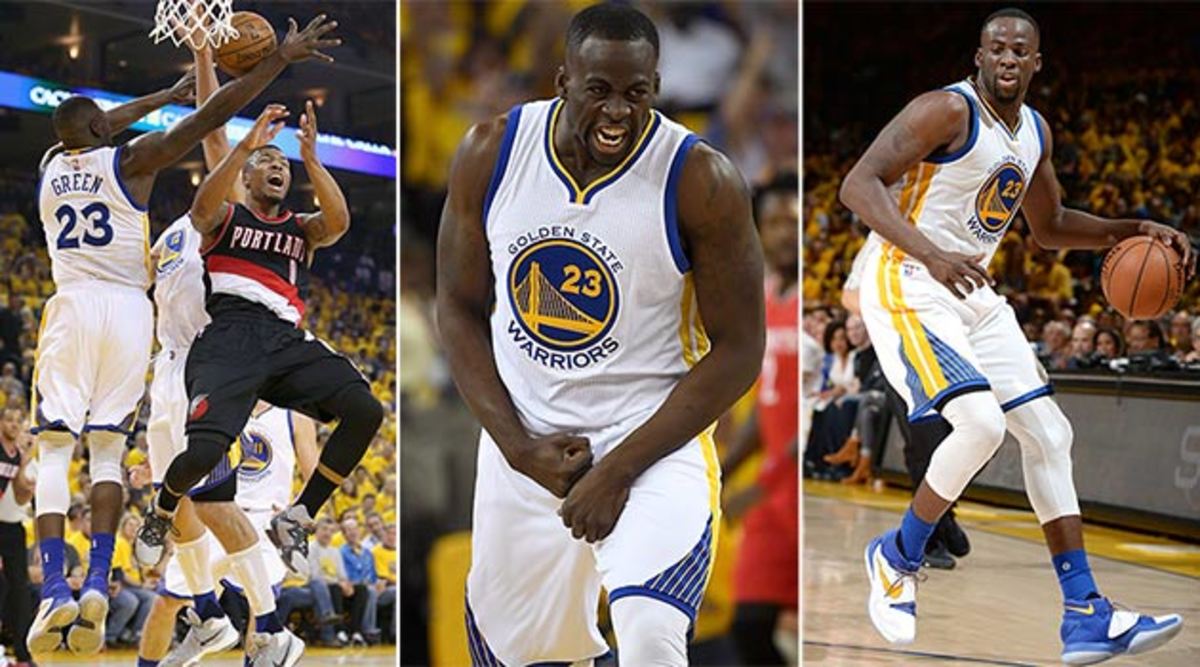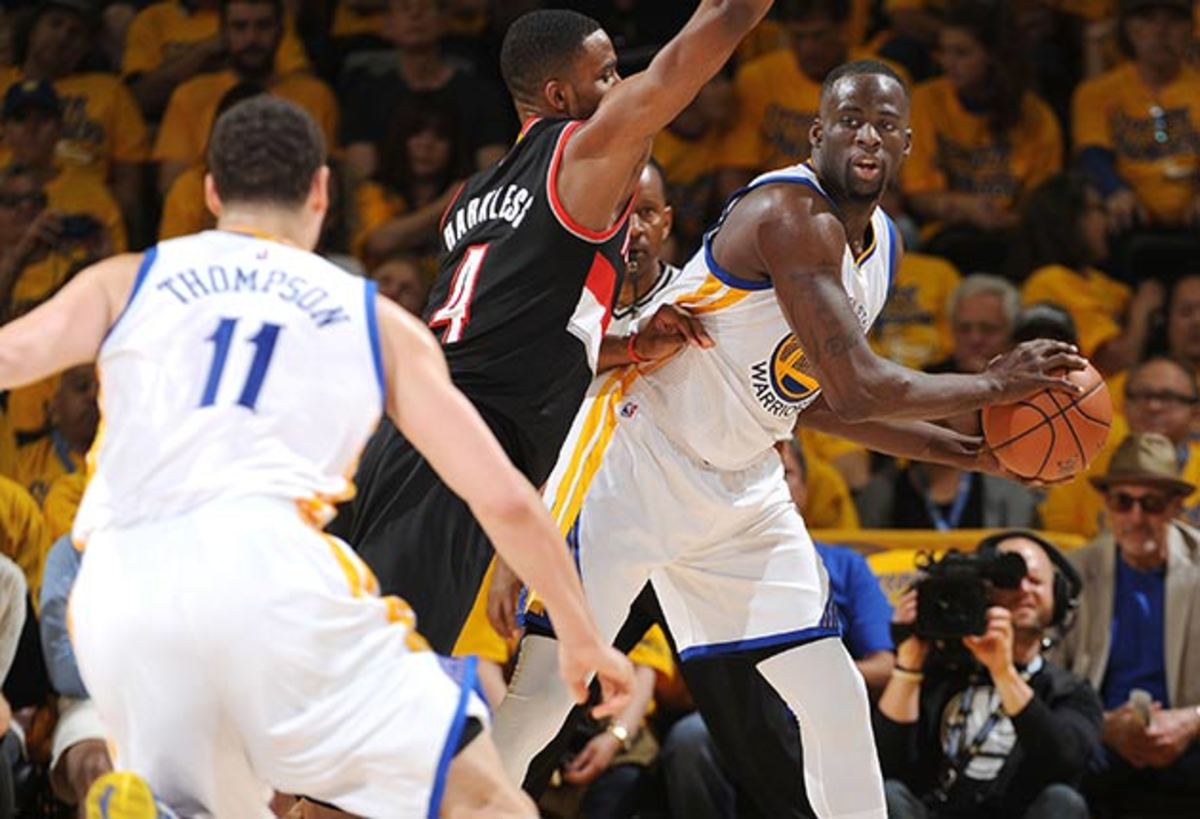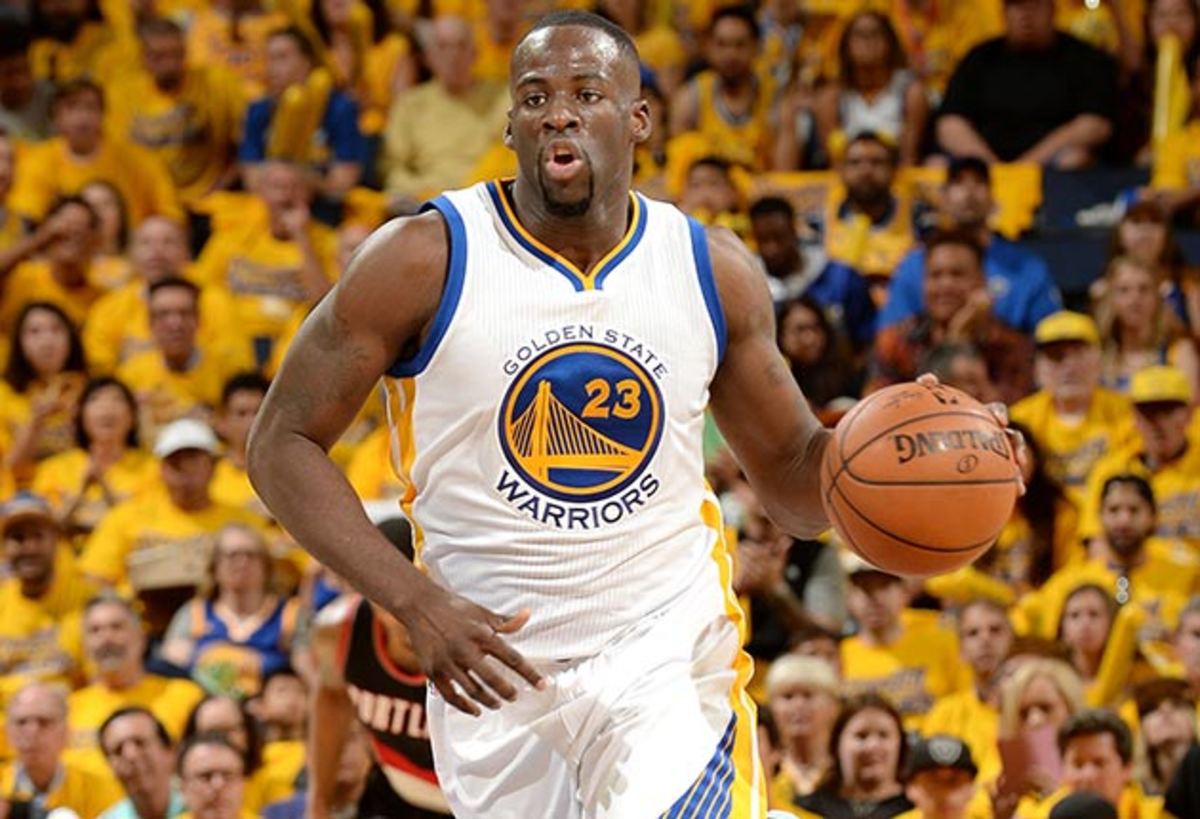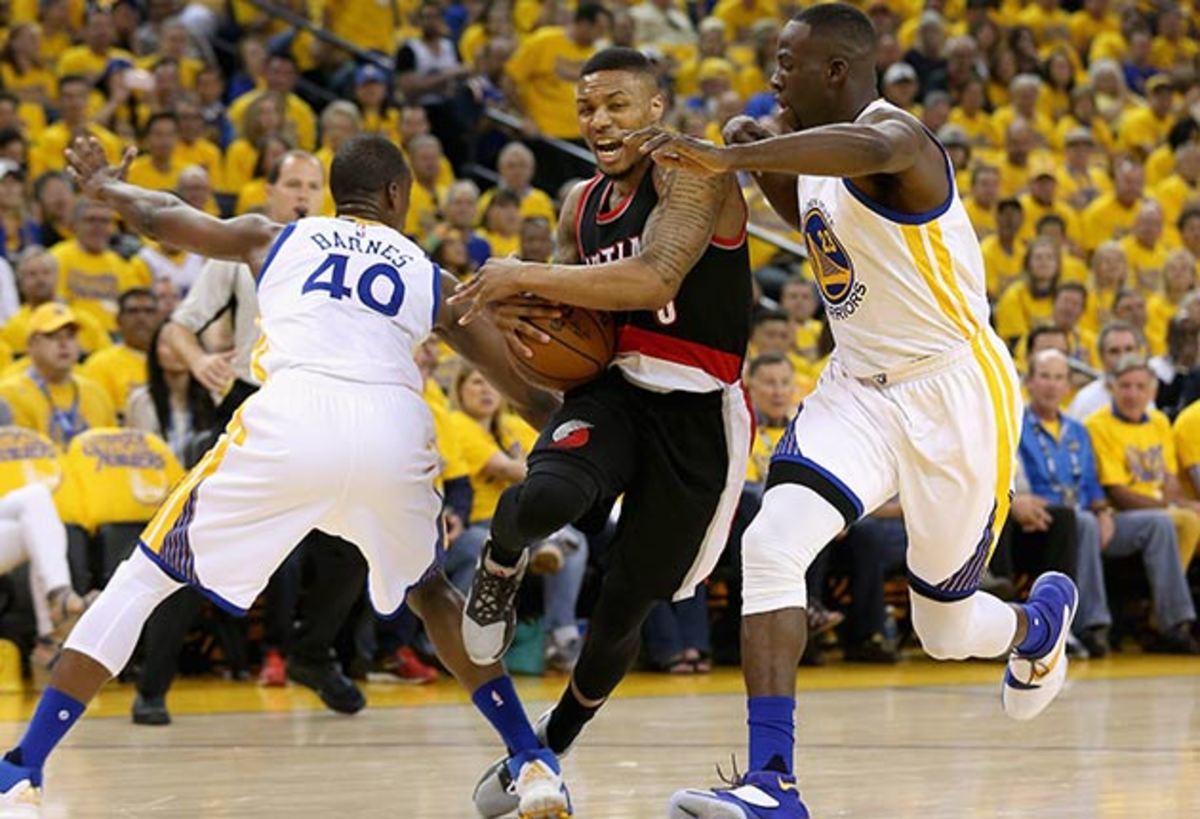Draymond Green stakes his claim as the NBA's 'best all-around' player

Get all of Ben Golliver's columns as soon as they’re published. Download the new Sports Illustrated app (iOS or Android) and personalize your experience by following your favorite teams and SI writers.
OAKLAND, Calif. — Golden State’s opening win over Portland in the second round had Draymond Green’s fingerprints all over it. The Warriors’ do-it-all All-Star played point forward on offense and locked down multiple positions on defense on his way to a triple double in the 118-106 victory at Oracle on Sunday.
Green, 26, served as an engine, an initiator and an intimidating presence, finishing with 23 points, 13 rebounds, 11 assists, three blocks and a steal in 37 minutes. In typical fashion, Green also posted the best plus/minus in the contest, finishing at +24 in the 12-point win.
Watching Green direct such an overwhelming offense and such a stifling defense was a sight to behold, and it was enough to lead one of his teammates to crown him with quite the superlative.
“Draymond is huge for us,” Warriors center Andrew Bogut said after the game. “His playmaking ability, his defensive ability. He's probably the best all-around player in the league at this point.”
When the sentiment was later relayed to Green, he said he was “comfortable” with the praise but not so comfortable that he was going to toot his own horn.
“I think there's a lot of great all-around players in the game,” he said. “You'll never hear me call myself that, but [if] they are going to call me that, I'll take it. I'm not going to shy away from it.”
• MORE NBA: Curry: 'Good' chance I play in Game 3 | Second-round schedule
Green has many, many basketball virtues. He plays hard, he plays intelligently, he plays with an edge, he can shoot from the perimeter, he hits the glass on both ends, he can push the tempo and run half-court sets, he has good vision and the ability to put his passes on target, he protects the rim, he provides timely and purposeful help defense, he can play multiple positions, he steps out comfortably to defend switches on the perimeter, and he doesn’t shy from the moment or shirk leadership duties.
“I didn't come out here and say I need to get a triple double,” Green said after a Game 1 in which all or nearly all of his skills were put to use. “I came out saying I need to do whatever it takes to help our team get a win and tonight that was a little bit of everything.”
Green is often overlooked in player rankings and similar conversations because he isn’t a volume scorer (he averaged a career-high 14 PPG this season) and he didn’t enjoy the name recognition advantage of being a former top draft pick (he lasted until the second round in 2012).
Practically speaking, the “Best All-Around Player” label usually refers to No. 1 offensive options that also happen to play defense. Guys like LeBron James, Paul George and Chris Paul usually come to mind. A player in Green’s mold—a No. 3 scorer with a “defense-first” reputation and only one All-Star appearance to his name—would usually be dismissed before the debate even begins.
Setting the terms for the “Best All-Around Player” discussion is difficult and prone to differences of opinion. Is it the player who does the most things well? Is it the player with the largest total impact? Is it the player with the best combination of great offense and great defense?
Whatever the preferred methodology, Bogut is right: Green deserves a spot at the table. Here are five arguments in his favor.

1. Green has a gigantic impact on both sides
Portland’s best moments in Game 1 came, not surprisingly, early in the second quarter when Green was on the bench. All of a sudden, the Blazers’ drives were producing successful looks in the basket area and the Blazers’ were stringing together a few defensive stops. Green’s absence was felt immediately and on both ends.
This impact is reflected in ESPN’s Real Plus-Minus (RPM), a statistical measure that gauges an individual’s impact while taking into account his teammates and opponents. Green led the league in RPM (+8.8) this season, barely edging James (+8.7), teammate Stephen Curry (+8.5) and Paul (+8.4).
RPM breaks down into both offensive (ORPM) and defensive (DRPM) components, which is particularly helpful for the “Best All-Around Player” conversation. As it turns out, Green is one of just two players to place in the top 10 in both ORPM and DRPM and one of just four players to place in the top 25 in both categories, as listed below.
• Draymond Green: No. 10 in ORPM, 3 in DRPM
• Kawhi Leonard: No. 9 in ORPM, No. 5 in DRPM
• LeBron James: No. 3 in ORPM, No. 25 in DRPM
• Nikola Jokic: No. 25 in ORPM, No. 10 in DRPM
Other players with “All-Around” reputations like Chris Paul, Paul George, and Paul Millsap fare well in both RPM categories.
Basketball-Reference’s Win Shares also attempts to measure a player’s overall statistical impact while splitting out into offensive and defensive components. Green ranked No. 10 in overall Win Shares this season (11.1), trailing Curry (17.9), Kevin Durant (14.5), Russell Westbrook (14), Leonard (13.7) and James (13.6).
When looking at which players fare well by both Offensive Win Shares and Defensive Win Shares, though, Green looks even better. He’s one of only six players to rank in the top 15 in both OWS and DWS.
• Stephen Curry: No. 1 in OWS, No. 10 in DWS
• Kawhi Leonard: No. 7 in OWS, and No. 4 in DWS
• Russell Westbrook: No. 4 in OWS and No. 13 in DWS
• LeBron James: No. 5 in OWS and No. 12 in DWS
• DeAndre Jordan: No. 15 in OWS and No. 3 in DWS
• Draymond Green: No. 14 in OWS and No. 6 in DWS
• LaMarcus Aldridge: No. 17 in OWS and No. 8 in DWS
• Kevin Durant: No. 2 in OWS and No. 24 in DWS
• Kyle Lowry: No. 8 in OWS and No. 19 in DWS
• Chris Paul: No. 6 in OWS and No. 25 in DWS
• Hassan Whiteside: No. 24 in OWS and No. 5 in DWS
• Al Horford: No. 25 in OWS and No. 9 in DWS
• Kemba Walker: No. 13 in OWS and No. 22 in DWS
The takeaway here: Conventional wisdom might exclude Green from the “Best All-Around Player” conversation because of the reasons listed above, but the major advanced statistics do not. From an offense/defense balance standpoint, Green is right there with the most obvious candidates—James, Leonard, etc.—in both RPM and Win Shares.
2. The Warriors dominate when Green is on the court
Hand in hand with Green’s strong performance in the impact statistics: Golden State’s strong play with him on the court. Thanks also to Green’s excellent health this season (he played more than 2,800 minutes in 81 games), he posted the best raw plus/minus of any player in the last 20 seasons, per NBA.com.stats.
With Green on the court, the Warriors outscored opponents by 1,070 points this season. Here’s how that compares with other top performers since 1996-97.
• 2016 Draymond Green: +1,070
• 2016 Stephen Curry: +1,022
• 2015 Stephen Curry: +920
• 2009 LeBron James: +870
• 2015 Draymond Green: +839
• 2016 Klay Thompson: +836
• 1997 Michael Jordan: +818
• 1997 Scottie Pippen: +807
It’s worth noting that other Hall of Famers (current and future) like Shaquille O’Neal, Tim Duncan and Paul Pierce also rank among the top performers in raw plus/minus over the last 20 years.
• MORE NBA: 10 most memorable moments from the first round
In case you’re curious, Green also leads all players so far in plus-minus during the 2016 playoffs at +120 through six games. Last year, he led all players in postseason plus-minus at +192, topping Curry (+163).

3. Green is a triple-double machine
Green’s triple double against the Blazers was the first by any player during the 2016 playoffs and the first since he posted one in Golden State’s title-clinching victory over Cleveland in Game 6 of the 2015 Finals. Last year, he joined James (3), Blake Griffin (3) and James Harden (1) as the only players to post triple doubles in the playoffs.
While the triple double has its advocates and critics, it is often associated with “All-Around” play. Would Oscar Robertson be mentioned as often as he is among the alltime greats if he didn’t average a triple double for a season? Would Fat Lever ever be mentioned if not for the triple double?
This season, Green posted 13 triple doubles, second only to Russell Westbrook (18) and tied for the fifth-most since 1983-1984, per Basketball-Reference:
• 2016 Russell Westbrook: 18
• 1989 Magic Johnson: 17
• 1987 Fat Lever: 16
• 1989 Michael Jordan: 15
• 2016 Draymond Green: 13
• 1997 Grant Hill: 13
• 1991 Magic Johnson: 13
• 2008 Jason Kidd: 13
• 1988 Magic Johnson: 12
• 2007 Jason Kidd: 12
Even more interesting, though, is how Green fares relative to other bigs in recent history. He’s really in a class by himself. Here's a look at the most triple doubles by power forwards or centers since 1983-84.
• 2016 Draymond Green: 13
• 1993 Charles Barkley: 6
• 2003 Kevin Garnett: 6
• 1994 David Robinson: 5
• 2000 Chris Webber: 5
That second list should highlight exactly how unique Green’s mix of skills is even compared to Hall of Fame caliber players. Bigs who consistently accumulate assists represent a very rare breed.

4. Green’s full stat line defies easy comparison
Green’s extended stat line from the regular season is gorgeous: 14 PPG, 9.5 RPG, 7.4 APG, 1.5 SPG, 1.4 BPG. Consider the stat sheet fully stuffed.
This season, Green was one of just nine players to average at least one steal and one block per game. Needless to say, none of the other eight players matched his rebounding and assist numbers. Indeed, no other player averaged 5+ RPG and 5+ APG to go along with those defensive stats.
It takes some serious digging to find players whose stat lines approximate Green’s overall production this season. Here are a few:
• 2014 Joakim Noah: 12.6 PPG, 11.3 RPG, 5.4 APG, 1.2 SPG, 1.5 BPG
• 2010 LeBron James: 29.7 PPG, 7.3 PRG, 8.6 APG, 1.6 SPG, 1 BPG
• 2009 LeBron James: 28.4 PPPG, 7.6 RPG, 7.2 APG, 1.7 SPG, 1.1 BPG
• 2008 LeBron James: 28.4 PPG, 7.6 RPG, 7.2 APG, 1.7 SPG, 1.1 BPG
• 2003 Kevin Garnett: 23 PPG, 13.4 RPG, 6 APG, 1.4 SPG, 1.6 BPG
• 2003 Chris Webber: 23 PPG, 10.5 RPG, 5.4 APG, 1.6 SPG, 1.3 BPG
• 1985 Larry Bird: 28.7 PPG, 10.5 RPG, 6.6 APG, 1.6 SPG, 1.2 BPG
Clearly, Green is out of his depth compared to those names (except Noah) when it comes to scoring. It’s still interesting to note, though, that the list of players who produce as much as he did in the secondary stat categories this season is mostly composed of blue-chip Hall of Fame talent. This is great company.

5. Green pairs easily with all types
One thing that might get lost about Green in the “Best All-Around” player discussion is the inherent value of a multi-talented big man, as the lists of two-way players above are dominated by perimeter players. One might argue that the gap between Green and the next big “All-Around Player” among big men is actually wider than the gap between, say, Curry and Paul or James and Leonard.
Adding one extra layer to Green’s value is his skill at holding down both the power forward and center positions. For example, DeAndre Jordan scores very well by both Offensive Win Shares and Defensive Win Shares but he forces the Clippers to play a certain way and match up a certain way when he’s on the court.
• MORE NBA: Sideline Strong: Craig Sager always on the bright side
Green helps Golden State play big, small and super small. It doesn’t matter if he’s paired with traditional centers like Andrew Bogut and Festus Ezeli, a combo big like Marreese Speights, a small-ball four like Harrison Barnes, or even smaller players like Andre Iguodala and Brandon Rush, Green more than makes it work.
Here’s how seven different frontcourt trios involving Green functioned this season. Note that all seven posted positive net ratings.
• Barnes, Green, Bogut: +14.6 in 607 minutes
• Rush, Green, Bogut: +9.1 in 314 minutes
• Iguodala, Green, Ezeli: +33.4 in 269 minutes
• Iguodala, Green, Bogut: +16.1 in 267 minutes
• Iguodala, Barnes, Green: +43 in 217 minutes
• Barnes, Green, Ezeli: +3.5 in 163 minutes
• Iguodala, Green, Speights: +23.5 in 100 minutes
Green’s ability to mix-and-match with various players at multiple positions and produce positive results is, frankly, LeBron-esque. That’s just one more reason why Green deserves to be included in this best “All-Around Player” conversation.
As a final note, Green’s best argument might come when this year’s All-NBA and All-Defensive Teams are revealed. He has a very real chance of being selected to both the All-NBA First Team and the All-Defensive First Team, joining Leonard, James and possibly Paul on the short list of players who are qualified for both.
If Green succeeds in locking down spots on both teams, perhaps his name will become more readily associated with the “Best All-Around” label.
